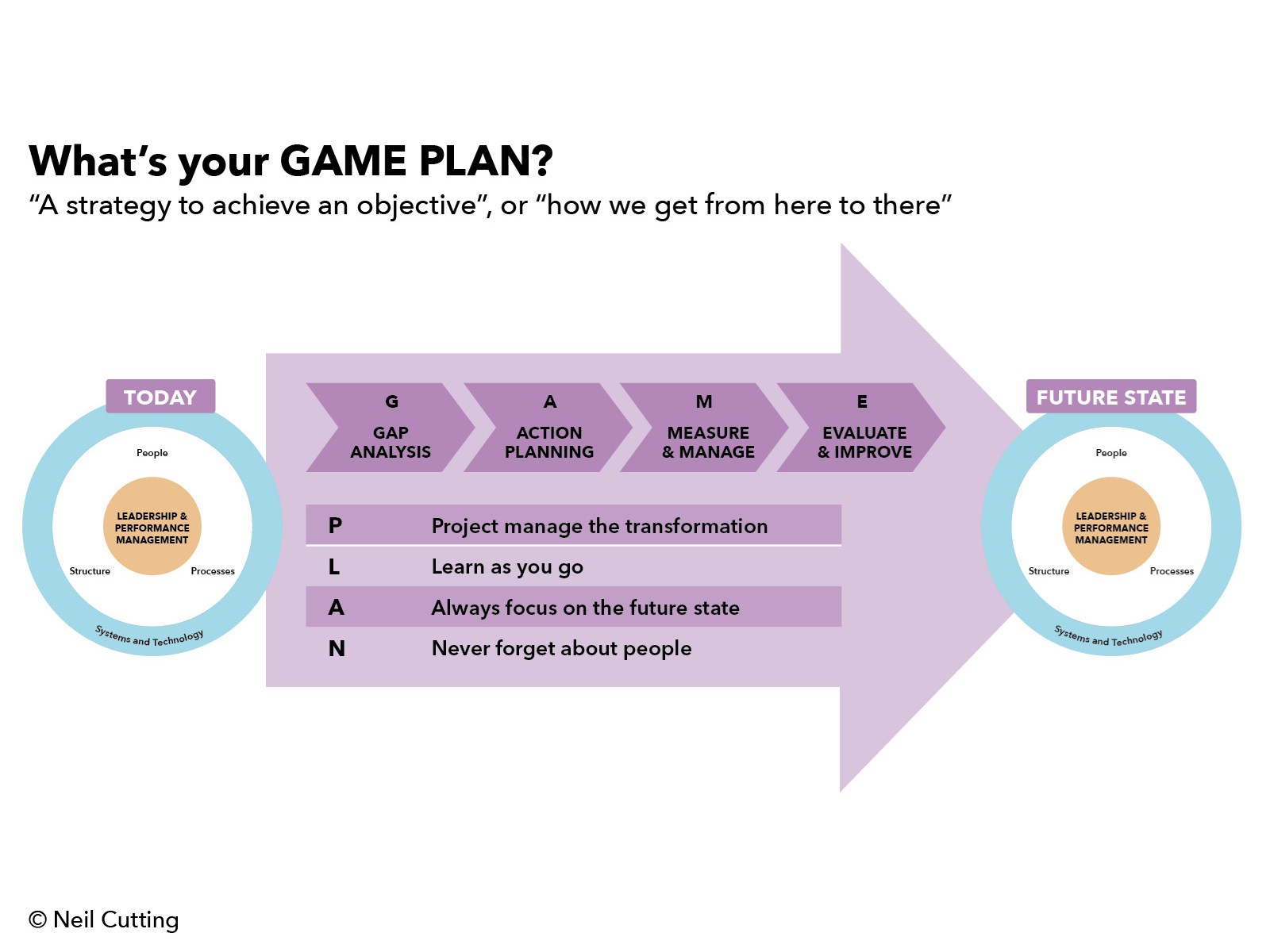Over the past few articles, we’ve covered the five perspectives of successful organisational transformation:
There will be catalysts or points in your career where these might become important. For example: let’s say you start a new role and you want to quickly assess the capability of your team and how they’re performing in the organisation. Looking at these different perspectives is a useful way to assess where you are and what the gaps might be. This gives you a bit of structure to help you get going, and makes sure that you’re thinking about things in a wide perspective.
Or you might have been managing a team for some time and have been making lots of iterative improvements as you’ve identified them. Now, you want to step back from the day-to-day and think about where you are at the present, and where you want to be in the future.
The thing to emphasise is that this approach with the five perspectives and the GAME PLAN FRAMEWORK can be applied to any function or any organisation. If the MD needs to restructure a business to become more client-facing or more product-centric, this methodology works. It also works in the case of a merger or an acquisition, where there’s a need to think about how the acquired business (and the business doing the acquiring) should adapt to fit with the approach of the organisation that acquired it.
Everything we’ve covered lays the groundwork for completing any project. Doing this exercise will ensure that your project will get going properly once you start. Not considering these five elements of organisational transformation may have a ripple effect that can threaten to derail your project at any stage through the process.
What’s your GAME PLAN?

Within these articles we also started to cover the GAME PLAN FRAMEWORK, which gives you a record of the current state of your team or organisation and what actions you need to take to bring these five elements on the journey with you.
We covered the GAME PLAN in detail in our people article. We will be covering this in more detail across the next series of articles. You’ll find the templates for these in our earlier pieces, linked above.
These templates can help you generate a GAP analysis, which looks at the maturity of each perspective – both today and your aspiration for the future. Then you have an ACTION PLAN, which breaks the desired tasks into manageable chunks with milestones (Scope) and Schedule. This format can subsequently be used to help you manage and measure your change project, using monthly traffic light status updates (using the BRAG approach).
You have probably used some of these techniques during your career without knowing it; I recently saw a CFO lay out a scorecard for their processes, people and structure. It wasn’t labelled as a maturity GAP analysis, but that’s what it was. Sometimes it can help to formalise this process in a template that can be shared and understood by the various stakeholders involved.
What happens next?
Our next series of articles will deliver practical advice on how to effectively project-manage change at your organisation. This will explore the GAME PLAN FRAMEWORK in more detail, together with ways to tackle common challenges in driving change. For example:
Action planning
- How to decide which strategic actions to take.
- How to determine the scope, schedule, cost and benefits, and risk of your project.
Manage and measure
- How to manage your project/programme successfully – determining your governance.
- How to measure and manage a pipeline of proposed projects (bigger than the money/time available).
- How to measure and manage both financial and non-financial benefits.
- How to manage difficult stakeholders.
- How to ensure you bring your team with you? People first approach (engagement/comms).
Need to know
The critical messages from this article that you need to take away:
- The five perspectives of organisational transformation create a solid foundation for any project GAP analysis.
- Not considering these perspectives could cause you to overlook critical weaknesses.
- Once you have completed your GAP analysis you need to follow the GAME PLAN FRAMEWORK to help deliver a successful transformation. This will be covered in detail in the subsequent series of articles by Neil Cutting.
Neil Cutting has held many CFO and transformation leadership roles with complex global organisations. Most recently he was Vice-President of Finance at Jacobs Solutions Incorporated, a $15bn Fortune 250 organisation. He is also a member of ICAEW’s Business Committee which represents global business members, and guest lectures on strategic performance at the University of Bath.
Related articles
Read related articles by Neil Cutting on finance transformation and the finance team toolkit:




